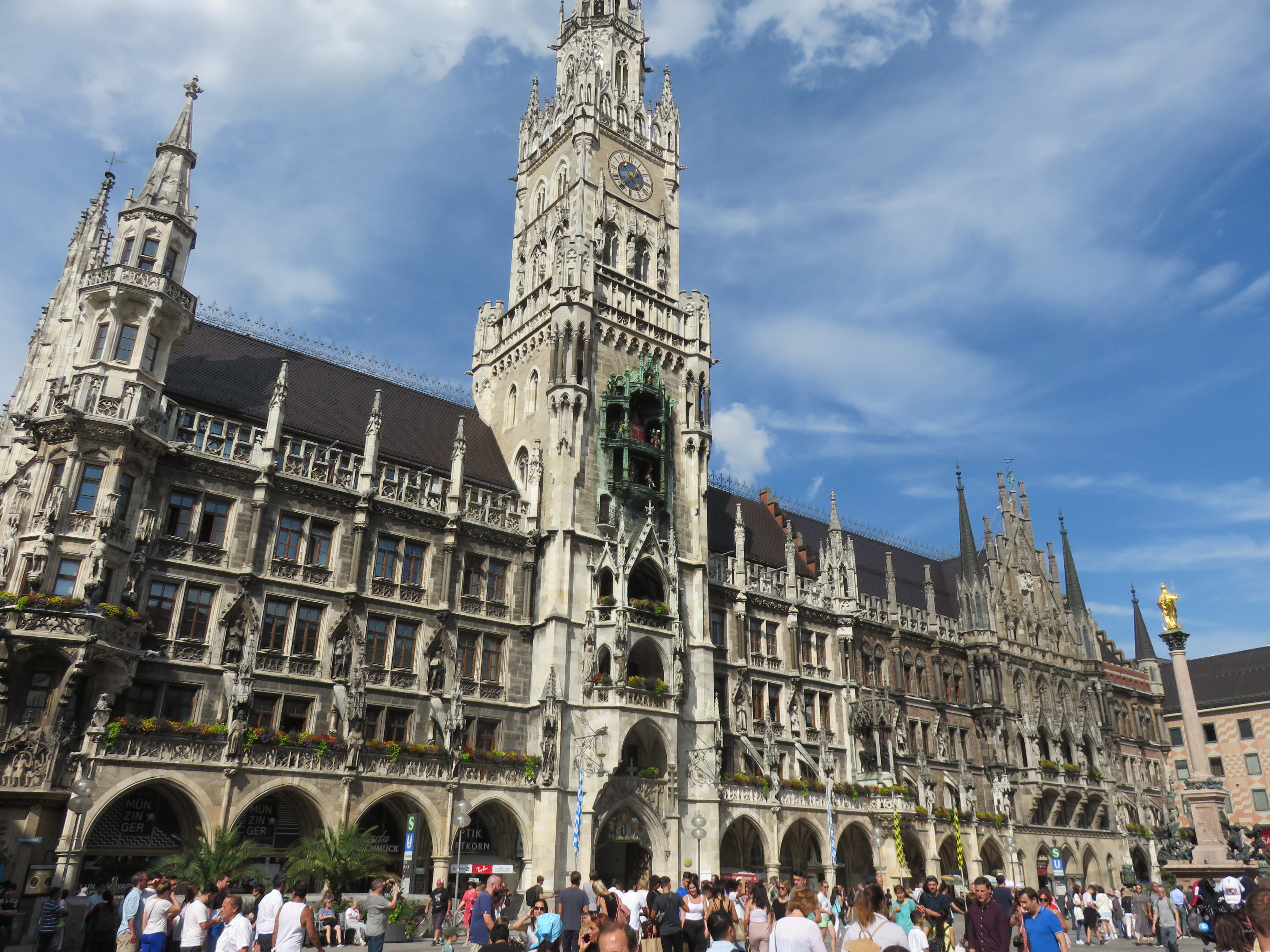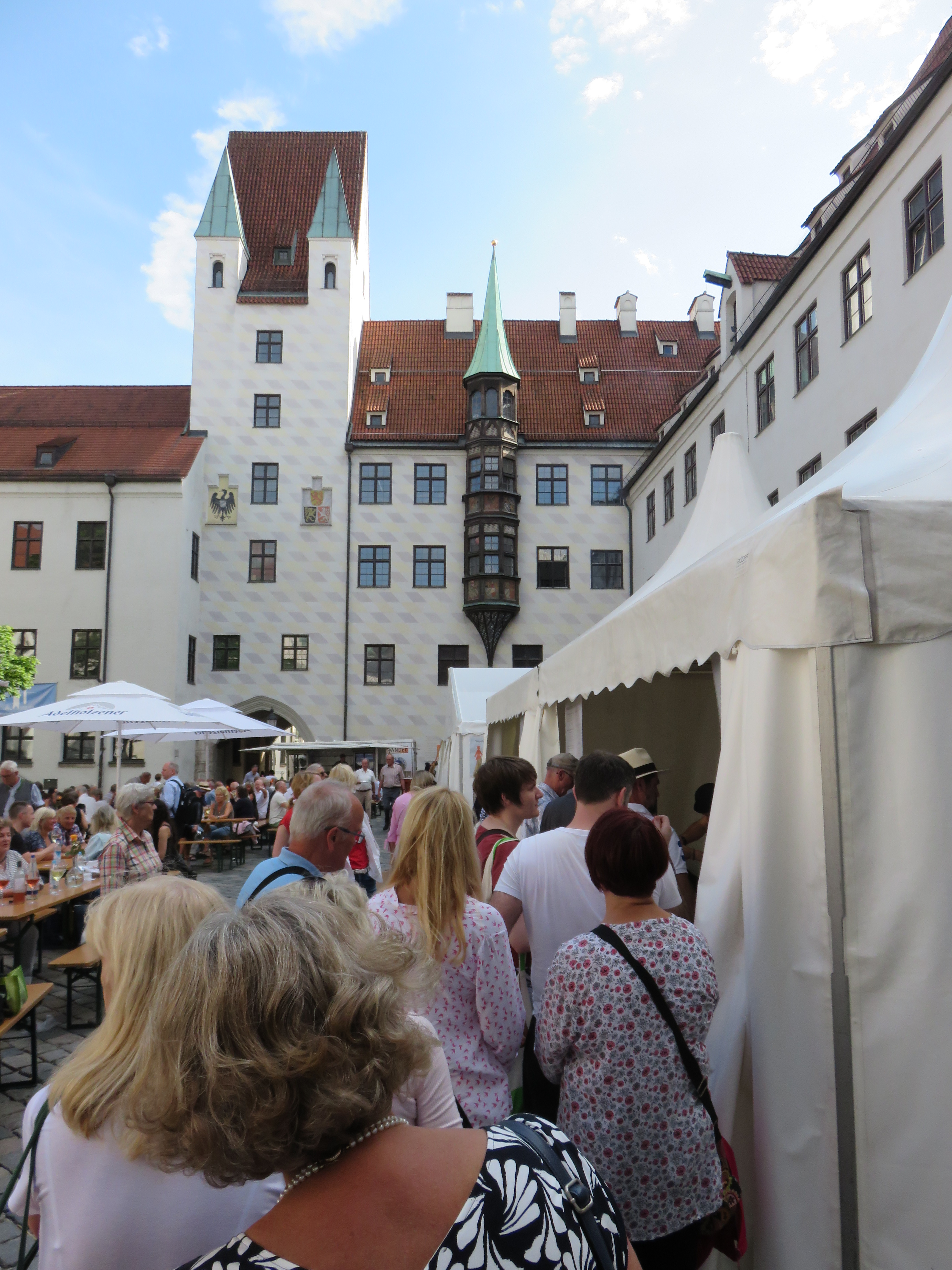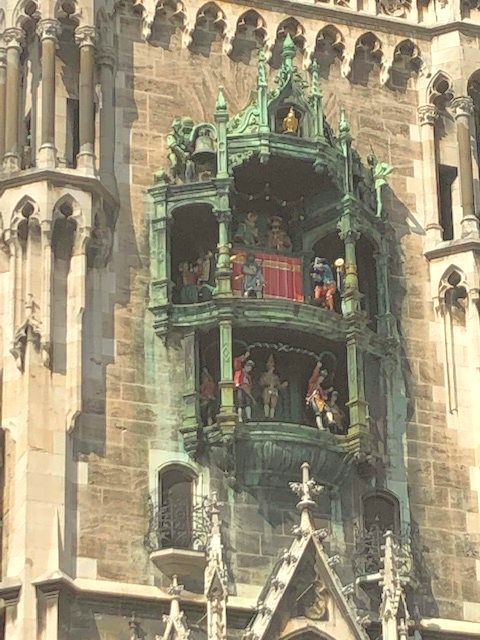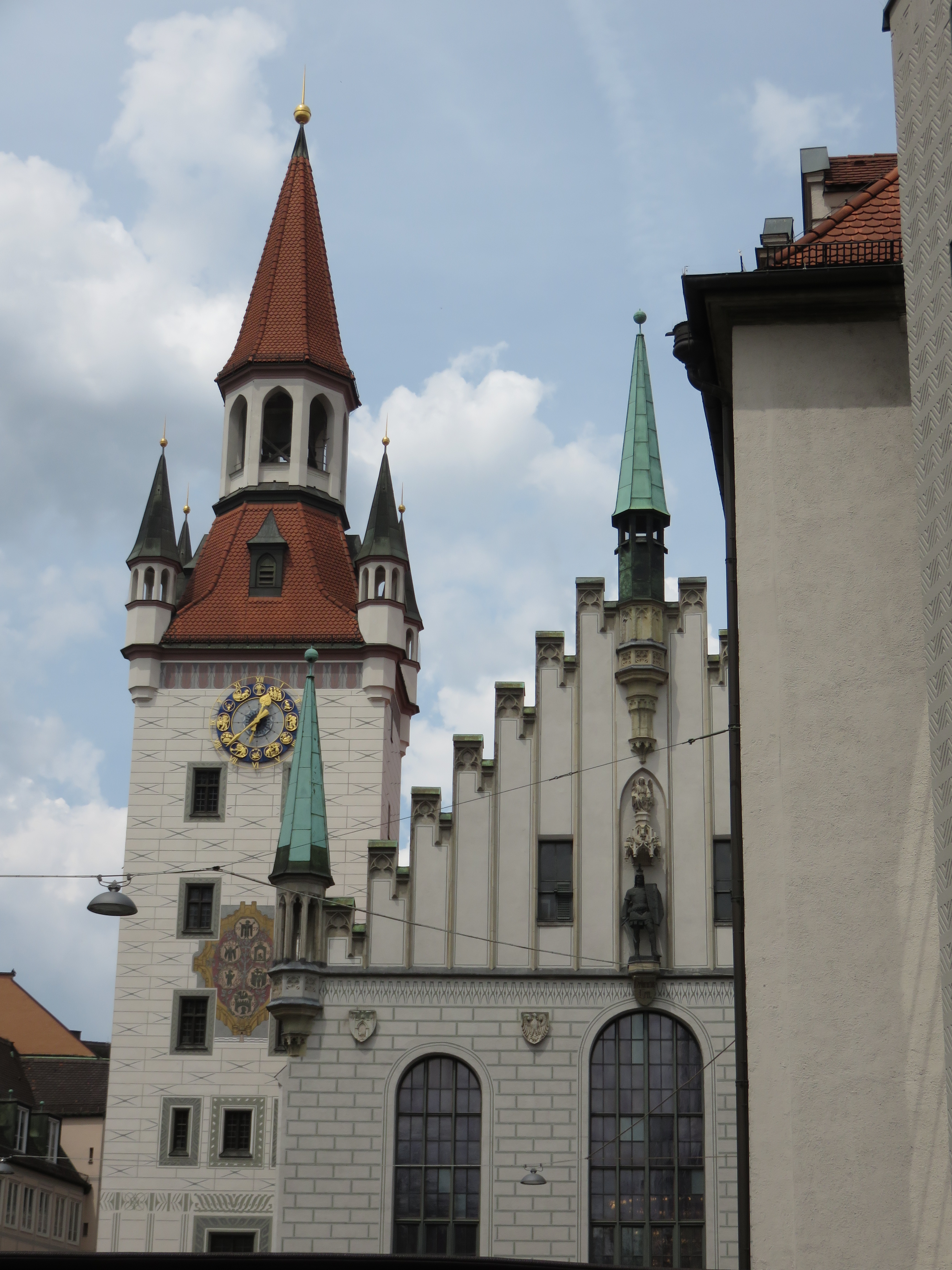Part 6: ALPINE ADVENTURES EXCEED EXPECTATIONS – MUNICH, GERMANY

Russ really lost his head over this accordionist!
In Part 5: Mozart brought music to the world, The Sound of Music rang in our heads, and the Eagle’s Nest reminded us of the destruction that greed, hatred, and supreme power can enable.
Munich is the capital of Bavaria. There are roughly one-and-a-half million people living in the city, who proudly have their own nationalistic dialect, and think of themselves as from München Bavaria, not Germany. Munich is known for its beer, Oktoberfest celebrations, museums, and international companies like the headquarters of BMW.
Where we stayed:
Eurostars Book Hotel must have been designed for people like me: readers and/or writers whose imaginations propel their lives. From the first moment we stepped insidethe modern two-year-old hotel and spotted the quotes from famous novels sketched across the ceiling and backdrop of the concierge desk, I felt comfortably at ease. Each floor of the hotel is themed with a different literary genre. There are quotes from world literature in each book’s originating language adorning guest room ceilings. A lending library is available.

The Marienplatz, Munich’s main square for over 1000 years, draws crowds.
This was the third hotel on this trip whose floors were paneled wood, with these being white wood. There were unusually large creamy white closets, pin-striped wallpaper, and plenty of room in the bathroom for shelving toiletries. The shower had a full enclosure so less chance for water to flood the floor, unlike the other showers with glass portioning only a third of the area. The AC worked quite well. The one quirky aspect is that the wall between the bathroom and the bed area is clear glass, with painted flowers flowing across it. When the bathroom light is on, everything is visible. The padded taupe headboard had reading lights attached that were larger than book lights. The breakfast buffet was first class. Coffee was obtained from two machines. No pot on the table. The location is excellent for access to Marienplatz, Munich’s main square for the past 1,000 years and where the action hums along until late in the evening.
What we saw:
Take the On-Off buses for as many days as you want to get around the city. Some of the attractions are too far by foot and even if you just want to get a broad perspective of Munich, the buses are the way to get it. We were on the red line. There is also a blue line. The buses are supposed to arrive at every stop every 20 minutes. That didn’t always occur, but if you saw the traffic congestion, you’d understand why that could happen. When you first buy tickets, you are handed earbuds to plug in for the guided tour, offered in eight languages.

Tucked in a courtyard was a WeinFest.
My husband Russ and I had later starts on the day while in Munich so weren’t able to get to all the attractions we wanted, but what we did was spontaneous and entertaining. For instance, we happened to stumble into an annual WeinFest celebration that goes on for two weeks before moving on to other host cities. It was in an empty courtyard square at Im Alten Hof between buildings. There were food and wine tents. The wine selections were local and high-end. The courtyard was packed with picnic tables. Easily a 1,000 people could be seated. People came and went, and you sat wherever you wanted. In the center, a DJ played American music from the 50s, 60s and 70s. The music wasn’t the focus. It was strictly added atmosphere, so it wasn’t loudly overbearing. No one danced. There was a variety of entertainment each night, from this DJ to bands. We had such a great time just immersing ourselves in the atmosphere, that we returned the next night as well. Same DJ, but this time a German couple spotted us, thought we looked interesting, and came over to join us. What a treat. We talked with them for hours and learned a lot about the city from their local perspective.
As we wandered, we noticed the abundance of shops selling cuckoo clocks, from miniature magnet-held ones that actually work, to large handcrafted ones whose figures dance merrily as the hour chimes. But the largest number of shops sell lederhosen and dirndl dresses. Of course, the “Wagner” store was obviously the best!

The entrance to Schloss Nymphenburg was begun as a summer residence.
Russ and I took the red on-off bus to Schloss Nymphenburg, begun as a summer residence while awaiting the 1662 birth of the long-awaited heir to the throne, Max Emanuel. It’s a sprawling complex redesigned in 1715 by court architect Joseph Effner and French landscape architect Dominique Girard. Without going further into the history, know that it’s a worthwhile attraction to wander through the gilded rooms, especially a side building housing the coaches used by the royal families throughout the years. They range from impressively ornate to more subdued models crafted in later years.

Just one of the many gilded coaches used by royalty on display.
What we learned:
Oktoberfest, an excuse for eating, drinking, doing the chicken dance, and celebrating while wearing traditional lederhosen and dirndl dresses was begun in 1810 to celebrate the wedding of Crown Prince Ludwig (who later became King Ludwig I) to Princess Teresa of Sassonia-Hildburghausen. All of Munich was invited to attend the celebration held in the fields fronting the city gate. The party was such a success that it has been held every year since. Of course, Oktoberfest festivities are also celebrated around the world. In Munich, Oktoberfest is held the last week of September through the first week of October. The same seven breweries who catered King Ludwig I’s wedding still have exclusive rights for the concession on the city’s celebrations. Supposedly, the breweries were begun when monks weren’t allowed to eat during Lent, but they could drink beer to get them through the 40 days! Three of the city’s famous breweries include Hofbrau, Lowenbraü, and Paulaner.

Lederhosen stores were everywhere, but obviously this is the best one!
Signature local dishes appear on most German menus: pretzels; Weisswürste (“white sausages”), which are stubby greyish-white sausages made from a mixture of finely minced veal and back bacon, then stuffed into pork casings; and Schweinshaxe, a roasted ham hock or pork knuckle. Accompanying dishes include knödel (potato dumplings) and krautsalad (salad made with white cabbage). I also spotted roasted duck served with red cabbage on most menus.

At the Hofbräuhaus, it’s an Oktoberfest party every night with an OomPahPah band.
Ludwig II, or he was sometimes referred to as Ludwig II Mad or the Fairy Tale King of Bavaria, had a thing for erecting fantasy castles. One of the more famous ones to visit in the area was influenced by Versailles in France. The Schloss Herrenchiemsee Castle on Herren Island in the Chiemsee Lake area is opulent. If you are staying within the city center, you’ll need transportation to visit.

Ludwig II created multiple fairy tale type castles. This is just one tiny part of his Schloss Nymphenburg.
Beer gardens have a protocol as to where you can sit. If there’s a tablecloth on the table, you must order food. No tablecloth means you can bring your own food but must purchase beer or wine. Beer gardens are places where families and friends come to socialize. The atmosphere is casual and amiable. There are usually lots of trees, which Russ was told is because the beer kegs are kept underground. The trees are there to protect the kegs from getting warm, not to keep the sun off patrons.
Odeonsplatz, named after the former concert hall, the Odeon, is a large square in central Munich that hosts yearly outdoor classical concerts.
The English Gardens lie next to the American Embassy. Larger than New York’s Central Park at more than 1.4 square miles, it contains many beer gardens including one that can hold up to 7,000 people. We wanted to get there, but didn’t.

The Rathaus-Glockenspiel clock has 43 bells and 32 life-sized figures that dance when the clock chimes.
The Rathaus-Glockenspiel clock, dating from 1908, has become a main tourist attraction on Marienplatz. It chimes daily at 11 and noon with an additional 5 pm chime during the summer. There are 43 bells and 32 life-sized figures. The top tells of the marriage of Duke Wilhelm V (who also founded the world famous Hofbräuhaus in Munich) to Renata of Lorraine. The bottom half is called Schäfflertanz (the coopers’ dance) and how that dance symbolizes perseverance and loyalty to authority. The actual dance is re-enacted live every seven years during Fasching (the German Carnival). The show lasts between 12 and 15 minutes.
The National Theatre was built between 1811 and 1815 and rebuilt in 1825 after being destroyed by fire. Four Richard Wagner operas premiered there. The historic opera house is home to the Bavarian State Opera, Bavarian State Orchestra and the Bavarian State Ballet.

National Theatre houses the Bavarian State Opera and Ballet.
While riding on the red tour bus, we passed by Deutsches Museum, recognized as the world’s largest museum of science and technology, with about 28,000 exhibited objects from 50 fields.
Beer production in Munich adheres to the purity laws established in 1516. The beer can only be made of hops, malted grains, water and yeast.
We ran out of time to visit the Olympic Park, constructed for the 1972 Summer Olympics, but know that the stadium can seat 78,000 people and there’s a second event center on the property that holds 12,000.

Frequent patrons at restaurants store their personal beer steins.
Where and what we ate and drank:
For traditional Bavarian food in a rustic, casual atmosphere, Münchner Stubn near the Eurostars Book Hotel is a winner. The food was so good and the prices so reasonable in this very pricey city, that after eating our first lunch there with Juanita and Darry Ferguson and Karen and Terry McKinnon from our Odysseys Unlimited Alpine Splendor tour group, we returned once more. We had been told that in many of the beer hall restaurants, locals store their own steins in provided cubbyholes labeled with their names, as does the Münchner Stubn. Russ ate a platter of two types of bratwurst, seasoned sauerkraut, mashed German-style hot potatoes, and bread. I practically inhaled a perfectly-roasted duck, dumplings that were gooey (typical of the area) and covered with a richly intense duck gravy, and red cabbage spiced differently than I’ve ever had it.

Russ’ bratwurst, seasoned sauerkraut and mashed German-style hot potatoes at Münchner Stubn.
The second time we ate at Münchner Stubn, I had chicken schnitzel that was thick rather than pounded to death, lightly breaded, fried and absolutely fantastic. It came with cucumber salad that was actually German potato salad with diced cucumbers integrated. Unexpected to have the potatoes instead of what I know to be cucumber salad, but again, really delicious. Russ wasn’t particularly hungry (and he knew he could help me out with my main entrée), so he ordered a small adult portion of chicken schnitzel. Small or not, he was charged the same as for a full portion. Interestingly, his was a bit thinner and his side was cranberry sauce.

One of many striking buildings.
We wandered away from the tourist area in search of a place that looked like it catered to locals. Found it at Anna Restaurant and Bar. We sat outside, with pillows they provide to place behind your back for comfort. The day was warm and we were tired, a perfect excuse for Russ to enjoy a cold local beer and for me to have the house special drink of the day, a Rosato Spritz made with prosecco, basil, and Ramazotti Rosato. It was sweeter than I prefer, but refreshing. As this was just an afternoon snack, Russ ordered their signature French fries doused in rosemary salt. I ate the Salat Ziegenkase (goat cheese salad). It came with four large squares of goat cheese, slices of pear, pumpkin seeds, toasted pecan pieces, sliced grapes and bread cubes that seemed to overwhelm the rest of the salad. Russ ordered a vanilla ice cream sundae, but he was not impressed with the quality of the ice cream.

Speisen und Getränke Biergarten.
On another of our adventures to immerse ourselves in the “real” life of the city, we found ourselves at Speisen und Getränke Biergarten, a large park-like setting divided into sections whether one was ordering food from the restaurant or from kiosks bordering the area, or just having beverages. The beer garden is heavily shaded. There’s a children’s playground. Right after 4 pm, the end of the workday here, people flooded in. We sat in the area in front of the restaurant to order lunch and of course, a wheat beer on tap for Russ and a local white wine for me. Once again I had a roasted duck quarter (crisp on the outside), red cabbage, and potato dumpling. Russ had roast pork, sauerkraut, and a pretzel dumpling. My potato dumpling was vastly different than Russ’. His was denser and dried. We also ordered a side of their homemade cabbage salad with bacon to see how it differed from other cabbage salads. It was like a marinated coleslaw with small pieces of bacon.

Another example of unique architecture.
Our two-week vacation was sadly over. Our Alpine Splendor tour and the extension trip to Munich was one of our favorite trips because of the diversity of activities, scenery, cultural insights, cuisine, the harmonious companionship of our Odysseys Unlimited tour group, and the superb leadership of Tour Director, Chris. This will definitely be etched indelibly in our minds as an incredible journey.
Karen Kuzsel is a writer-editor based in the Orlando area who specializes in the hospitality, entertainment, meetings & events industries. She is an active member of ILEA and MPI and is now serving on the 2019 – 2020 MPI Global Advisory Board for The Meeting Professional Magazine for the fourth consecutive year. She is a member of the Society of Professional Journalists. Karen writes about food & wine, spas, destinations, venues, meetings & events. A career journalist, she has owned magazines, written for newspapers, trade publications, radio and TV. As her alter-ego, Natasha, The Psychic Lady, she is a featured entertainer for corporate and social events. karenkuzsel@earthlink.net; www.ThePsychicLady.com; @karenkuzsel; @thepsychiclady. Food photos for this series by Karen Kuzsel. All other Photos by Russ Wagner, a retired government planner/builder who has a passion for trains, travel and taking photographs.
www.eurostarshotels.co.uk/eurostars-book hotel.html
www.schloss-nymphenburg.de/englisch/palace/
www.destination-munich.com/national-theatre.html
www.deutsches-museum.de/index.php
www.destination-munich.com/olympic-park.html
www.hansimglueck-burgergrill.de/speisen-und-getraenke/

Leave a Reply
Want to join the discussion?Feel free to contribute!